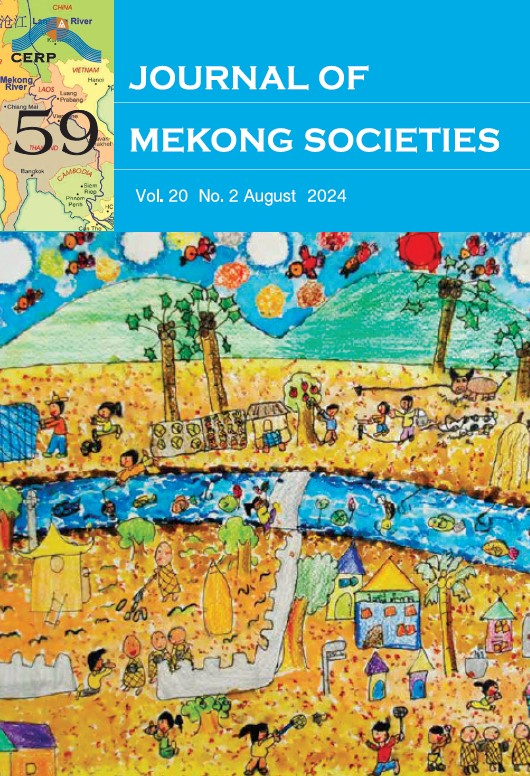The Story of /mà:k/, from ‘Betel Nut’ to ‘Board Game’: A Tai Study in Cognitive Linguistics through Compound Nouns
Main Article Content
Abstract
This research paper is a synchronic study of the tendency of the grammaticalization pathway of the noun /mà:k/, focusing on its semantic extension from ‘betel nut’ to ‘board game,’ with data collected through compound nouns in some Tai languages currently spoken in Thailand. In the analysis, we employ cognitive linguistics such as functional-typological grammar and cognitive semantics as its basis. The result shows that the pathway begins with a true or regular noun referring to a specific edible plant, ‘betel nut.’ The noun has been grammaticalized, with some semantic bleaching or generalizing, to a class term. As a class term, its meaning has further extended through four distinctive phases: ‘edible plant;’ ‘inedible plant;’ ‘small, round object;’ and ‘board game.’ The pathway of /mà:k/ is quite complex due to the fact that while the extension from the regular noun to the first two plant categories is via semantic generalization, the further extension to the last two object categories does not persist via the same model: it is via metaphorical models. The five categories are overlapping, gradient from a true noun to many class-term phases.
Article Details

This work is licensed under a Creative Commons Attribution-NonCommercial-NoDerivatives 4.0 International License.
References
DeLancey, S. (1986). Toward a history of Tai classifier systems. In C. Craig (ed.). Noun classes and categorization. (pp. 437-451). Amsterdam, Philadelphia: John Benjamins Publishing Company.
DeLancey, S. (1997). Grammaticalization and the gradience of categories: Relator nouns and postpositions in Tibetan and Burmese. In J. Bybee, J. Himan and S.A. Thompson (Eds.). Essays on language function and language type. (pp. 51-70). Amsterdam, Philadelphia: John Benjamins Publishing Company.
Givón, T. (2001). Syntax I. Amsterdam/Philadelphia: John Benjamins Publishing.
Hass, M. R. (1964). Thai-English students’ dictionary. Stanford, CA: Stanford University Press.
Kingkham, W. (2017). Phasa Thai thin. (In Thai) [Thai Dialects]. Bangkok: Kasetsart University Press.
Kövecses, Z. (2000). Metaphor and emotion: Language, culture, and body in human feeling. Cambridge: Cambridge University Press.
Kövecses, Z. (2002). Metaphor: A practical introduction. Oxford: Oxford University Press.
Kövecses, Z. and Radden G. (1998). Metonymy: Developing a cognitive linguistic view. Cognitive Linguistics, 9(1), 37-78.
Lakoff, G. (1987). Women, fire, and dangerous things: What categories reveal about the mind. Chicago and London: University of Chicago Press.
Lakoff, G. and Johnson, M. (1980). Metaphors we live by. Chicago: University of Chicago Press.
Lakoff, G. and Turner, M. (1989). More than cool reason: A field guide to poetic metaphor. Chicago: University of Chicago Press.
Mehrtash, H., Duncan, K., Parascandola, M., David, A. Gritz, E.R., Gupta, P.C., Mehrotra, R., Amer Nordin, A.S., Pearlman, P.C., Warnakulasuriya, S., Wen, C.P., Zain, R.B., and Trimble, E.L. (1 December 2017). Defining a global research and policy agenda for betel quid and areca nut. Lancet Oncol, 18(12), 767-775. Doi:10.1016/S1470-2045(17)3046-6. PMID 29208442.
Ostapirat, W. (2005). Kra-Dai and Austronesian: Notes on phonological correspondences and vocabulary distribution. In L. Sagart, R. Blench and A. Sanchez-Mazas (Eds.). The Peopling of East Asia: Putting together archaeology, linguistics and genetics. (pp. 107-131). London/ New York: Routledge-Curzon.
Rosch, E. (1973). Natural categories. Cognitive Psychology, 4, (pp. 328-350).
Rosch, E. (1977). Human categories. In N. Warren (Ed.). Studies in cross-cultural psychology. (pp. 1-49). London: Academic.
Rosch, E. (1978). Principles of categorization. In E. Rosch and B.B. Lloyd (Eds.). Cognition and categorization. (pp. 27-48).
Royal Society. (2013). Royal Institute Dictionary 2011. Bangkok: Nanmeebooks.
Singnoi, U. (2005). Kamnamprasom: Sat lae sin nai kan sang kham Thai. (In Thai) [Compound nouns: Sciences and arts in Thai word combination]. Bangkok: Chulalongkorn University Press.
Singnoi, U. (2008). Khamnam khambongklumnam lae laksananam: Muatmu thi taektang thapson lae lailueam. (In Thai) [Nouns, class terms and classifiers: Different, overlapping, and gradient categories]. Language and Linguistics, 26(2), 21-28.
Warren, B. (1999). Aspects of referential metonymy. In K.U. Panther and G. Radden (Eds.). Metonymy in language and thought. (pp. 121-138). Amsterdam: John Benjamins.
Wongwattana, U. S. (2014). Kham riak chue phuet baep phuen ban Thai: Kansueksa cheng phasasat prueksasat chattipan. (In Thai) [Thai folk plant names: A study in ethno-botanical Linguistics]. Bangkok: Chulalongkorn University Press.
Wongwattana, U. S. (2016). Kham bong klum nam. (In Thai) [Class terms]. Songklanakarin Journal of Social Sciences & Humanities, 22(2), 91-122.
Wongwattana, U. S. (2022). Auto-part terms in Thai: A cognitive semantic analysis. MANUSYA: Journal of Humanities, 25, 1-25.
Wongwattana, U. S., Intajamornrak, C., Chinakarapong, O., Salepot, K., and Aungtrakul, A. (2018). Phumpanya tang phasa lae kansuepsan phasa klum chatiphan Tai phak nuea ton lang: Krabuanthat mai nai kansuksa phasa lae wannakam thongtin. (In Thai) [Language wisdom and inheritance of Tai ethnic groups in the Lower Northern Part: A new paradigm in the study of Thai regional dialects and literature] (Research Reports). Phitsanulok: Naresuan University.
Wongwattana, U. S. and Jirananthanaporn, S. (2014). Kansuksa khamriak chue phuet nai klum pasa chattiphan Tai nai khet phak nuea. (In Thai) [A study of plant names in ethnic Tai languages in the Northern Part] (Research Report).
Zeng, H. (2019). A Cognitive-pragmatic approach to metaphor and metonymy in brand names: A case study of film titles. Taiwan Journal of Linguistics, 17(1), 1-48.
Website
Alcohol and Drug Foundation. (2021). Betel nut. Retrieved March 25, 2023, from https://adf.org.au/drug-facts/betel-nut/


